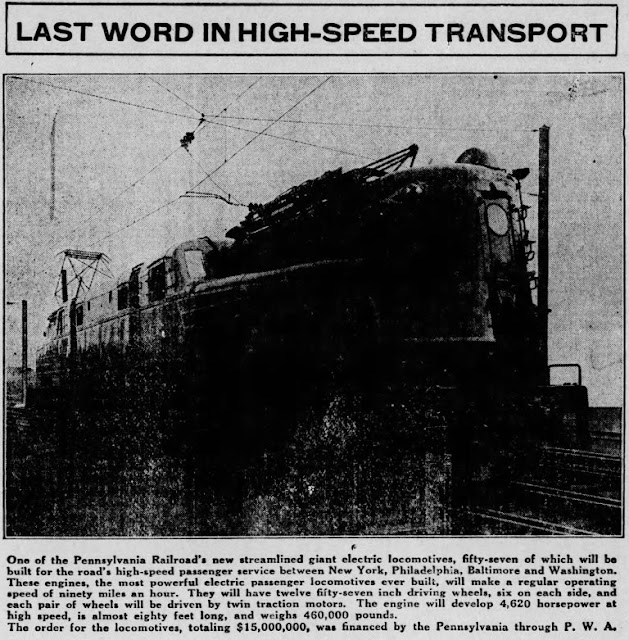Above: The locomotive in the foreground is Pennsylvania Railroad 4800 or, as it came to be known over the decades, "Old Rivets." It's an electric train, shown here beside an older steam-style train. It's called "Old Rivets" because it was the first of its kind, its body was put together with rivets, and all of the subsequent locomotives of this class (GG-1) utilized welding instead of rivets. During the New Deal, somewhere between 57 and 101 of these locomotives were built with loans from the New Deal's Public Works Administration (PWA). Each one cost about $250,000 (about $5.2 million in 2021 dollars). Photo courtesy of the National Archives.
Above: The description for this photograph, showing "Old Rivets" ca. 1935, reads: "A new high speed electric locomotive ready to start its run between Washington and New York. PWA funds financed the purchase of this train." As you can see from the work sign in the photo above, "Old Rivets" and its offspring were part of a larger effort to modernize and electrify America's railways. In its 1939 report, America Builds: The Record of PWA, the Public Works Administration notes: "Total loans to the Pennsylvania Railroad amounted to $70,165,000 [about $1.5 billion in 2021 dollars] for completing electrification of its New York to Washington division, building 68 electric locomotives, and 7,000 new freight cars, and purchasing 33 electric locomotives and 97,787 tons of rail" (p. 189, footnote 2, emphasis added). Not all of the 101 locomotives noted in this statement were necessarily of the "Old Rivets" model, and other sources suggest that about 57 "Old Rivets" style locomotives were built (see next photo and caption). Photo courtesy of the National Archives.
Above: The caption for this photo--which comes from The Perry County Democrat (Bloomfield, Pennsylvania), November 28, 1934-- notes that the 57, PWA-financed, "Old Rivets" style locomotives were, at the time, "the most powerful electric passenger locomotives ever built." Further, an earlier article in The Gazette (Cedar Rapids, Iowa) reported that PWA loans allowed the Pennsylvania Railroad to make "one of the largest equipment orders in the history of American railroading" (November 10, 1934, p. 1). And all of this financing and ordering allowed thousands of railroad workers to return to their jobs, and would benefit about 100 other industries (see, e.g., "Huge Electrification Program of P.R.R. in Full Swing," The News-Herald (Franklin, Pennsylvania), March 28, 1934, p. 1). Photo from newspapers.com, used here for educational and non-commercial purposes.
Above: A timetable brochure for the Pennsylvania Railroad, from April 24, 1938. The locomotive shown on this brochure is one of the PWA-financed GG-1 locomotives (but not "Old Rivets"). Image scanned from a personal copy.

Above: In the timetable brochure, the Pennsylvania Railroad boasts its New Deal-facilitated, "All-Electric Mileage." Image scanned from a personal copy.

Above: A postcard showing "Old Rivets" in 1976. The back of the postcard reads, "Bicentennial colors on Conrail [formerly Pennsylvania Railroad] 4800 add another milestone to this famous electric locomotive. No. 4800 was the first GG1, built in 1934, and the only one with a riveted carbody. It is also the first locomotive to wear the Conrail name. Shown at Harrisburg, Pa., April 12, 1976." Photo by James P. Shuman, postcard by Audio Visual Designs (Earlton, New York), used here for educational and non-commercial purposes.

Above: A postage stamp of "Old Rivets." According to the Wikipedia entry for "Old Rivets," the locomotive "was designated a Historic Mechanical Engineering Landmark by the American Society of Mechanical Engineers (ASME) on April 23, 1983," and "In 2012, PRR 4800 was inducted into the North America Railway Hall of Fame for its contribution to the railway industry." Image above scanned from a personal copy.

Above: "Old Rivets," at the Railroad Museum of Pennsylvania (RMP). According to RMP, "The much talked about GG-1 was the result of a desire to have a reliable, fast, powerful, and numerous other requirements all in one electric locomotive package. In the end the final product proved to be better than anyone including [the Pennsylvania Railroad] could have hoped for... GG-1’s as a locomotive class were the longest serving of any locomotive class whether it be steam, electric, or diesel in the U.S. and abroad." RMP notes that "Old Rivets" ran "until almost 1980," i.e., nearly half-a-century. Photo from the website of the Railroad Museum of Pennsylvania, accessed March 14, 2022, and used here for educational and non-commercial purposes.




No comments:
Post a Comment